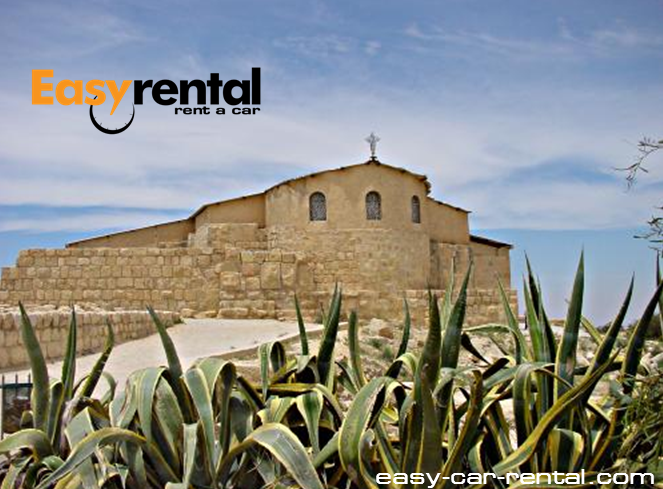Mount Nebo | Easy Rental Amman Airport Car Rental
Jordan Tourist Sites - Attraction

Mount Nebo is a 1,000m (3,300ft) high mountain located 10km/6 mi NW of Madaba in Jordan, opposite the northern end of the Dead Sea. According to ancient tradition, this is the mountain from which Moses saw the Promised Land before he died.
Because of its connection to Moses, Mt. Nebo has long been an important place of Christian pilgrimage. Excavations led by the Franciscans, who own the site, have uncovered significant remains of the early church and its magnificent Byzantine mosaics. A simple modern shelter dedicated to Moses has been built over them.
In the Bible
Then Moses climbed Mount Nebo from the plains of Moab to the top of Pisgah, across from Jericho. There the Lord showed him the whole land.... Then the Lord said to him, "This is the land I promised on oath to Abraham, Isaac and Jacob when I said, 'I will give it to your descendents.' I have let you see it with your eyes, but you will not cross over into it."
And Moses the servant of the Lord died there in Moab, as the Lord had said. He buried him in Moab, in the valley opposite Beth Peor, but to this day on one knows where his grave is. --Deuteronomy 34:1-6
History
In the 4th century AD a sanctuary, mentioned by the pilgrim nun Egeria, was built on Mount Nebo (Fasaliyyeh in Arabic) to honor Moses, possibly on the site of an even older structure. The church was finished by 394 AD and had three east apses flanked by funerary chapels on the north and south sides.
In the 6th century, the church was enlarged and transformed into a basilica with a sacristy and new baptistery (whose surviving floor mosaics date from c.530 AD). Soon the church was the heart of a large monastery and pilgrimage center that would thrive for nearly six centuries.
The site was abandoned by 1564 and remained mostly neglected for several centuries more. Finally, in 1993, the site was purchased by the Franciscans, who excavated and restored the area. On March 19, 2000, Pope John Paul II visited the site during his pilgrimage to the Holy Land, planting an olive tree next to the Byzantine chapel for peace.
Today, Mount Nebo is an active Franciscan monastery, the headquarters of the Franciscan Archaeological Institute, and a popular stop for pilgrims and tourists alike.
What to See
Rising over 700m above the Jordan Valley, Mount Nebo offers spectacular views of the Promised Land as seen by Moses. On the platform at the summit is a modern sculpture by an Italian artist representing Moses' staff and Jesus' words in John 3: "As Moses lifted up the serpent in the wilderness, so must the Son of Man be lifted up."
Elements of a triple-apse Byzantine basilica were uncovered by archaeologists in the 1930s, and have been incorporated into the structure of the modern church building, known as the Memorial Church of Moses. The modern additions to the church are very simple, consisting of little more than a shelter over the fascinating excavations and ancient mosaic floors.
Just inside the entrance to the left is the excavated Old Baptistery, which has one of the most interesting ancient mosaics in Jordan. The baptistery and the mosaic can be precisely dated to August 531 thanks to a Greek inscription, which also names the three workers who created it and the bishop at the time (Elias).
The Old Baptistery mosaic is in remarkably pristine condition because another one was laid over it just a few decades later in 597. The underlying mosaic remained hidden for nearly 1,400 years until it was discovered in 1976 when the one on top was removed for restoration (it now hangs on a wall).
The mosaic of 531 is a large square divided into four strips of scenes of men and animals, surrounded by a chain-style border. The top two sections depict fierce hunting scenes: a shepherd fighting a lion, a soldier fighting a lioness, and two horseback hunters defeating a bear and wild boar.
The lower scenes are pastoral but with a touch of the exotic: a shepherd watching his goat and sheep graze in the shade of trees; an ostrich on a leash held by a dark-skinned man; and a boy holding the leashes of a zebra and a spotted animal that looks very much like a camel but might be intended to represent a giraffe.
There are more mosaics in the nave and side aisles of the church, including some fragments of the 597 mosaic pavement. The oldest mosaic in the church is a braided cross displayed on the south wall.
Also hanging here are mosaics of animals from the Church of George in Mukhayyat. One of these is from 536 and has an inscription that some believe is the earliest example of Arabic script in Jordan (others argue it is old Aramaic).
In the far right-hand corner of the church is the New Baptistery (597 AD), which was previously a funerary chapel. It includes a small mosaic originally from the threshold bearing the greeting, "Peace to all."
Next to the New Baptistry, a lovely mosaic cross from the original 4th-century church stands on a modern altar in its original location. A photograph of the Pope praying at the same altar is proudly displayed.
Next to the exit door is the Theotokos Chapel, added in the 7th century where three rooms of the monastery previously stood. Its apse has a mosaic of a square object that may be a ciborium (vessel for the Eucharist) or altar canopy, accompanied by bulls and gazelles. The floor of the chapel is paved with mosaics of plants and flowers.
Foundations of the ancient monastery are visible outside.




